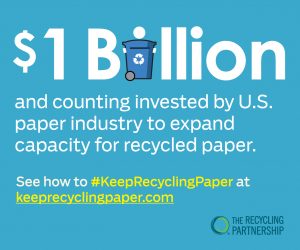
Scene from ISRI2019 in Los Angeles.
Stakeholders from a variety of recycling industry sectors convened for the annual ISRI2019 convention last week. Here are some takeaways from the residential recycling portion of the event.
The Residential Recycling Summit, hosted by the Institute of Scrap Recycling Industries (ISRI) at its annual convention in Los Angeles last week, brought together MRF operators, municipal program representatives, brand owners, recycling advocacy groups and other sectors. Presenters discussed material challenges and looked for solutions to common challenges facing the industry today.
OCC will continue its rise: The trends driving more OCC in the single-stream recycling system are going to intensify, according to research from recovered fiber consulting firm Moore & Associates. Susan Cornish, an associate with the firm’s sustainability practice, outlined numerous retail chains that have closed down but noted that e-commerce has more than offset that trend. She cited an estimate that e-commerce has created seven times the number of jobs that were lost in the retail sector. What does that mean for the recycling sector? The Amazon effect is not going away anytime soon and is only going to increase. Get ready for more and more OCC in the residential stream.
Mixed paper sees more interest: OCC usage is increasing worldwide, driven by the growing containerboard market, while other grades are generally steady or decreasing in use. Still, end markets for mixed paper in the U.S. and elsewhere are slowly growing. Bill Moore, president of Moore & Associates, noted a variety of mill projects in the works that are planning to use some amount of mixed paper in their feedstock. The lead time on purchasing mixed-paper stock-preparation equipment, used by mills bringing in the material, used to be roughly three months but has grown to 10 months due to more equipment orders.
“When you have a raw material that’s at $0 it looks pretty attractive,” Moore said. Still, he said one of the factors creating some amount of risk in this space is the potential for China to reverse course and allow in mixed paper again. But he said, as many analysts have forecast, that it’s very unlikely the Chinese government changes its mind. “Mixed paper is not always going to be at the [pricing] level it is today,” he said, but it will certainly be depressed in pricing “for quite a while.”
An increase in mixed-paper markets is crucial to residential recycling success. Moore pointed to Pratt Industries, a mill operator making products with 100 percent recycled content and incorporating 50 percent mixed paper into its containerboard mix. He noted that mixed paper markets within 200 miles of Pratt facilities are “relatively stable” compared with other regions.
Helping at the curb: The final workshop of the residential recycling segment asked attendees to brainstorm legislative and voluntary initiatives that could improve curbside recycling in some way. Attendees floated a variety of proposals that could clean up the stream, bolster end markets or provide financial assistance to the processing sector. For instance, one idea was a sort of extended producer responsibility fee on direct mail senders, levied by the U.S. Postal Service, that would go toward improving mixed-paper processing. Other ideas included program changes to shift toward multi-stream, simplifying the list of accepted materials, imposing minimum mixed-paper-use requirements on containerboard mills, and more.
Getting specific on contamination: The Recycling Partnership hosted a contamination outreach workshop, offering ideas on how to most effectively communicate with residents. One tactic is to avoid general messaging and instead focus on specific materials. Running a campaign specific to how to properly recycle one problem material can resonate more than overwhelming residents with too much information on all materials in the stream. Additionally, this method can generate resident interest in learning more about proper recycling, thereby lifting the quality of other materials.
Non-recyclable packaging is increasingly labeled as such: Keeping the wrong materials out of the curbside cart is just as important as getting the right materials in. A significant number of non-recyclable products are being clearly identified through the How2Recycle program, a project of the Sustainable Packaging Coalition.
The majority of How2Recycle labels bear the “easily recycled” message, said Kelly Cramer, director of program management for How2Recycle. But 30 percent of the labels How2Recycle has issued display the non-recyclable product messaging.
Greater collection needed for brand owner commitments: Nestlé Waters North America believes the U.S. recycling rate needs to increase dramatically for the company to meet its recycled-content goals. The U.S. recycling rate hovers around 34 percent, and John Caturano of Nestlé’s packaging sustainability program predicted that a 70 percent recycling rate is closer to what the industry will need to meet the recycled plastic demand from brands. And brands, he said, are critical to lifting the plastics recycling industry by creating that demand.
“It’s going to take organizations like Nestlé and others to really help cultivate and mature those markets,” Caturano said. And for those organizations to effectively boost those markets, Caturano pointed to the importance of long-term supply contracts. These partnerships allow both partners to make investments with confidence there will be a buyer or supplier to help make the spending pencil out.
Photo credit: Colin Staub/Resource Recycling, Inc.
More stories about local programs
- Study links tagging tactics to lower contamination rates
- Interstate Waste buys North Atlantic in Connecticut
- Iowa firm recycles wind turbine blades into concrete



